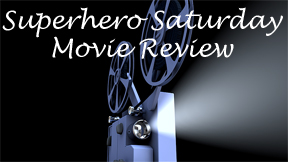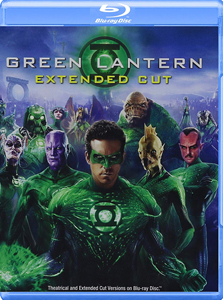“Green Lantern” (2011) has a reputation for being garbage, but it’s a perfectly fine adaptation of the DC superhero who was created in 1940 by Alan Scott and Martin Nodell. If you go in hearing about how bad it is, you might even think “Hey, that wasn’t so bad.” Since my superhero-watching journey is partly for the sake of learning about the major figures in comic-book lore, I found this to be a painless piece of homework.
Sort of like The CW
It’s sort of like watching a big two-parter in a CW DC series. Indeed, top-credited writer Greg Berlanti, who had created the cute “No Ordinary Family” one year prior, parlayed “Green Lantern” into a position as overseer of the CW’s Arrowverse, which started in 2012 with “Arrow.” (Was the “Green” dropped from “Green Arrow” because of the stigma of this film?)
Veteran director Martin Campbell (“The Mask of Zorro,” some “James Bond” films) helms “Green Lantern” in competent fashion as we split time between Earth and space. The space scenes are flat and green-screeny, making the movie look simultaneously expensive and cheap.

“Green Lantern” (2011)
Director: Martin Campbell
Writers: Greg Berlanti, Michael Green, Marc Guggenheim
Stars: Ryan Reynolds, Blake Lively, Peter Sarsgaard
Hal Jordan’s (Ryan Reynolds) Green Lantern suit also looks kind of CGI’d, as does the face of Sinestro (Mark Strong), even though he is basically human other than having maroon skin. It’s a flat, empty-feeling design aesthetic overall, but it’s not distractingly bad.
Reynolds keeps this film afloat. In his third superhero role (following “Blade: Trinity” and “X-Men Origins: Wolverine”), he tones down the shtick as hotshot pilot Jordan is selected as the first human in the galactic Green Lantern Corps. Jordan’s arc is light – he suspects the Corps has made a mistake by choosing him, and needs to step up to save the human race – but Reynolds is easy to like.
An origin story with pseudo-gravitas
There’s a lot of pseudo-gravitas common to superhero origin stories here, and also some inherent goofiness – after all, Hal’s power is that he can manifest functional objects out of nothing. (Need a cannon to take on the bad guy? Just think it up.) It’s kind of surprising that “Green Lantern” doesn’t go for more laughs, but at the same time it’s rather refreshing that Reynolds doesn’t.
As love interest Carol, Blake Lively looks lovely across from Reynolds, and it’s not surprising that they got married a year later.
Peter Sarsgaard is compelling as the human scientist villain, Hector Hammond, who – after being infected by an alien — can read minds. His brain literally grows as he “evolves” in the sense of the Philip K. Dick short story “The Infinites” (1953). It’s a shame that his villainy is more based on petty jealousy than advanced knowledge. But Sarsgaard makes Hector more engaging than he is on the page, and the design of Hector in monster form marks the film’s best special effects work.

The space scenes mostly consist of Hal and other Corps members talking to the Guardians, wizard-like beings with big brains similar to Hector’s who send the Lanterns out on missions around the galaxy. A twist on the Jedi Council, they reside on a sparse asteroid in the void and pontificate about the value of will (symbolized by green) and the danger of fear (yellow).
One of the Guardians pulls a quick Anakin Skywalker and accidentally becomes a supervillain who feeds on fear, and the grand finale features Hal taking on this Guardian who manifests as a giant smoke monster in the city. When people complain about intangible CGI supervillains, this is an example.
More forgettable than harmful
As bad as “Green Lantern’s” reputation is, no one’s career seemed to be seriously dinged by it. Taika Waititi (later to direct “Thor: Ragnarok”) plays Hal’s best friend, and in retrospect his comedic talents aren’t tapped here. In one of his final roles, the late Michael Clarke Duncan plays the voice of Kilowog, the big alien dude who spars with Hal in training.
Among the co-writers, Marc Guggenheim joined Berlanti in the Arrowverse, and Michael Green went on to some remarkable credits like “Logan” and “Blade Runner 2049.” The fourth writer, Michael Goldenberg (“Contact,” “Harry Potter and the Order of the Phoenix”), set down his pen for the rest of the decade.
Other than “The Dark Knight Rises,” “Green Lantern” is the last DC movie before the launch of the DC Extended Universe with 2013’s “Man of Steel.” Hal Jordan hasn’t yet appeared in the DCEU (although some Green Lanterns are glimpsed in “Justice League”), and Reynolds remains a good fit for the role. If he were to pop up in the DCEU, it wouldn’t be the worst thing to happen to the saga.
When an alien crash-lands on Earth, it’s humanity’s first extraterrestrial encounter, so this might be the point of contention for why “Green Lantern” can’t fit into the DCEU. Angela Bassett’s portrayal of Amanda Waller lines up nicely with Viola Davis’ turn in “Suicide Squad.”
But the main issue is that this is a safe, Berlantized take on a beloved comic character. It’s offensively mediocre to many viewers. I found it to be just fine, but granted, “Green Lantern” doesn’t make me lament the lack of a sequel or inspire me to put up an argument against the haters.

